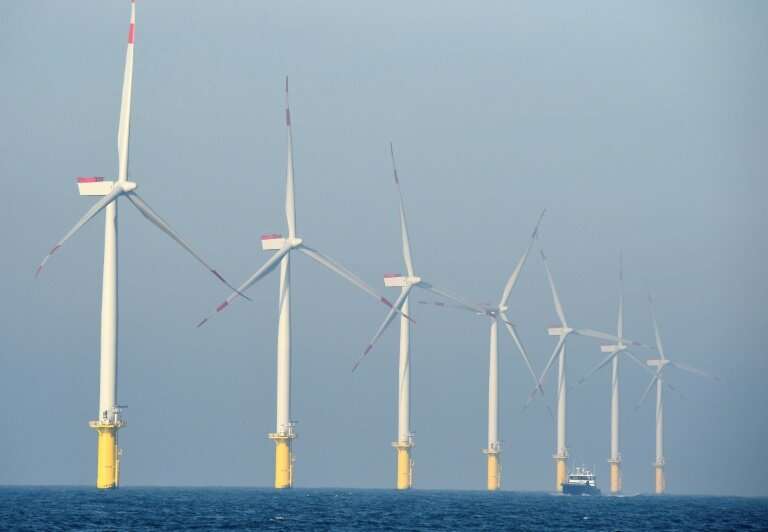Three things to know as Germany opens massive ocean wind park

Chancellor Angela Merkel on Tuesday officially opened a massive wind farm in the Baltic Sea, calling it a project of "national significance" for Germany's "energy transition" towards renewables.
Here are three things to know about the Arkona wind park.
Baltic's largest wind park
Arkona's 60 turbines tower out of the Baltic between the German island of Ruegen and the Swedish shoreline to the north.
Erected in just three months last year, they are already supplying 385 megawatts of electricity—enough for around 400,000 family homes.
French energy provider Engie has signed a contract to buy electricity for four years from operator OWP Arkona, a joint venture between Germany's Eon and Norway's Equinor.
Electricity will be routed through a French-built substation whose 150 kilometres of cables link up the wind generators.
Engineers affectionately dubbed the hardware "the multi-socket adaptor" after the familiar household gadget.
The project showcased "the German contribution, also the contribution of highly developed industrial nations to developing renewable energy," Merkel said, thanking both France and Norway for their involvement.
"If you look at the historical responsibility that we have, since we emitted a lot of carbon dioxide into the air, it's a question of justice and of development cooperation" to nurture climate-friendly technology for others to adopt, she added.
'Energy transition' on back foot?
Germany had long been seen as a pioneer in the switch to renewable energies, but Merkel's 2011 decision to exit the generation of nuclear power after the Fukushima disaster knocked the country back.
Rather than emissions-free fission plugging the gaps left by variable output from wind and sun, Berlin has had to fall back on intensely polluting brown coal and other fossil sources.
Today, renewables account for 38 percent of Germany's energy mix, and are slated to hit 65 percent by 2030.
"We must stick to that," Merkel said, recalling that "renewable energy is already the largest pillar of our energy supply, showing how it's shifted from a little niche into the centre".
But the federal government has missed its targets in the past, giving up last year a goal to reduce greenhouse emissions 40 percent compared with 1990 levels by 2020.
"It will take a lot of effort to achieve our targets for 2030," the chancellor acknowledged.
On land, Germany's much-lauded "Energiewende" (energy transition) policy is struggling, with subsidies for wind turbines on the way out and the cost of transmitting electricity to consumers high.
One kilowatt-hour (kWh) costs 30 euro cents ($0.34) or twice as much as in neighbouring France, still well supplied with electricity from nuclear plants.
From land to sea
While land-based turbines may be running out of puff, Germany has been building them at sea for 10 years—despite initial scepticism.
Observers at first warned of high costs, and upsets like storms or construction failures plagued the early attempts.
But costs have been squeezed and techniques improved in the meantime, with 20 percent of Germany's wind energy now coming from the sea.
North Sea and Baltic wind parks boast more than 1,300 windmills with a capacity of around 6.4 gigawatts.
Importantly, seaborne wind power is less vulnerable to Nimbyism—"not in my backyard"—complaints from locals about spoiled views, noise or dead birds.
Environment groups have warned about risks specific to the maritime generators, with birds still falling victim to them and the noise of the rotors tormenting some sea mammals, such as porpoises.
© 2019 AFP





















